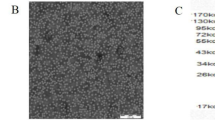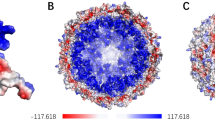Abstract
Porcine circovirus type 2 (PCV2) causes increased mortality and poor growth or weight loss in apparently healthy swine. Therefore, methods to detect PCV2-specific antibodies in swine serum are important for prevention, diagnosis, and control of PCV2-associated diseases (PCVAD). In this study, PCV2 virus-like particles (VLPs) were used to develop a rapid, simple and economical indirect enzyme-linked immunosorbent assay to detect (with high sensitivity) PCV2-specific antibodies in swine serum. The PCV2 capsid protein (Cap) was overexpressed in E. coli after optimizing the cap gene. Subsequently, the soluble Cap was rapidly purified in one step by automated fast protein liquid chromatography (FPLC). The purified PCV2 Cap was shown by transmission electron microscopy and gel filtration chromatography to be capable of self-assembling into VLPs in vitro. Using the purified VLPs as antigens, optimal operating conditions for the VLP ELISA were determined. The concentration of PCV2 VLPs was 1 µg/ml per well, and the dilution factors for swine serum and horseradish peroxidase (HRP)-labeled goat anti-pig antibody were 1:150 and 1:4000, respectively. Out of 241 serum samples tested with this assay, 83.4 % were found to be positive. Importantly, the VLP ELISA had a total coincidence rate of 97.4 % (74/76) compared to an Ingezim PCV2 ELISA IgG assay. In summary, this rapid, inexpensive VLP ELISA has the potential to greatly facilitate large-scale investigations of PCV2-associated serotypes.





Similar content being viewed by others
References
Segales J (2012) Porcine circovirus type 2 (PCV2) infections: clinical signs, pathology and laboratory diagnosis. Virus Res 164(1–2):10–19. doi:10.1016/j.virusres.2011.10.007
Segalés J, Kekarainen T, Cortey M (2013) The natural history of porcine circovirus type 2: from an inoffensive virus to a devastating swine disease? Vet Microbiol 165(1):13–20
Bucarey SA, Noriega J, Reyes P, Tapia C, Saenz L, Zuniga A, Tobar JA (2009) The optimized capsid gene of porcine circovirus type 2 expressed in yeast forms virus-like particles and elicits antibody responses in mice fed with recombinant yeast extracts. Vaccine 27(42):5781–5790. doi:10.1016/j.vaccine.2009.07.061
Marcekova Z, Psikal I, Kosinova E, Benada O, Sebo P, Bumba L (2009) Heterologous expression of full-length capsid protein of porcine circovirus 2 in Escherichia coli and its potential use for detection of antibodies. J Virol Methods 162(1–2):133–141. doi:10.1016/j.jviromet.2009.07.028
Nainys J, Lasickiene R, Petraityte-Burneikiene R, Dabrisius J, Lelesius R, Sereika V, Zvirbliene A, Sasnauskas K, Gedvilaite A (2014) Generation in yeast of recombinant virus-like particles of porcine circovirus type 2 capsid protein and their use for a serologic assay and development of monoclonal antibodies. BMC Biotechnol 14:100. doi:10.1186/s12896-014-0100-1
Trible BR, Suddith AW, Kerrigan MA, Cino-Ozuna AG, Hesse RA, Rowland RR (2012) Recognition of the different structural forms of the capsid protein determines the outcome following infection with porcine circovirus type 2. J Virol 86(24):13508–13514. doi:10.1128/JVI.01763-12
Liu C, Ihara T, Nunoya T, Ueda S (2004) Development of an ELISA based on the baculovirus-expressed capsid protein of porcine circovirus type 2 as antigen. J Vet Med Sci/Jpn Soc Vet Sci 66(3):237–242
Pumpens P, Grens E (2002) Artificial genes for chimeric virus-like particles. In: Khudyakov YE, Fields HA (eds) Artificial DNA: methods and applications. CRC Press LLC, Boca Raton, pp 249–327
Wu PC, Lin WL, Wu CM, Chi JN, Chien MS, Huang C (2012) Characterization of porcine circovirus type 2 (PCV2) capsid particle assembly and its application to virus-like particle vaccine development. Appl Microbiol Biotechnol 95(6):1501–1507. doi:10.1007/s00253-012-4015-2
Wu PC, Chien MS, Tseng YY, Lin J, Lin WL, Yang CY, Huang C (2008) Expression of the porcine circovirus type 2 capsid protein subunits and application to an indirect ELISA. J Biotechnol 133(1):58–64. doi:10.1016/j.jbiotec.2007.09.015
Nawagitgul P, Harms PA, Morozov I, Thacker BJ, Sorden SD, Lekcharoensuk C, Paul PS (2002) Modified indirect porcine circovirus (PCV) type 2-based and recombinant capsid protein (ORF2)-based enzyme-linked immunosorbent assays for detection of antibodies to PCV. Clin Diagn Lab Immunol 9(1):33–40
Sun SQ, Guo HC, Sun DH, Yin SH, Shang YJ, Cai XP, Liu XT (2010) Development and validation of an ELISA using a protein encoded by ORF2 antigenic domain of porcine circovirus type 2. Virol J 7:274. doi:10.1186/1743-422X-7-274
Shang SB, Li YF, Guo JQ, Wang ZT, Chen QX, Shen HG, Zhou JY (2008) Development and validation of a recombinant capsid protein-based ELISA for detection of antibody to porcine circovirus type 2. Res Vet Sci 84(1):150–157. doi:10.1016/j.rvsc.2007.02.007
Bachmann MF, Jennings GT (2010) Vaccine delivery: a matter of size, geometry, kinetics and molecular patterns. Nat Rev Immunol 10(11):787–796. doi:10.1038/nri2868
Welti S, Sydler T, Wiederkehr D, Pospischil A, Hassig M, Burgi E, Sidler X (2012) Postweaning multisystemic wasting syndrome (PMWS) and porcine dermatitis and nephropathy syndrome (PDNS) in Switzerland in the years 2003–2006. Schweizer Arch Tierheilkd 154(10):417–427. doi:10.1024/0036-7281/a000378
Acknowledgments
This project was supported by the Research Foundation of Hunan Provincial Education Department, China (grant no. 15A086); Hunan Provincial Natural Science Foundation of China (grant no. 2015JJ2082); Hunan Provincial Natural Science Foundation of China (grants nos. 13JJ1022/S2013J5050); and the General Program of National Natural Science Foundation of China (grants nos. 31270819 and 31372406)
Author information
Authors and Affiliations
Corresponding author
Ethics declarations
Conflict of interest
We declare no conflict of interest.
Rights and permissions
About this article
Cite this article
Zhang, Y., Wang, Z., Zhan, Y. et al. Generation of E. coli-derived virus-like particles of porcine circovirus type 2 and their use in an indirect IgG enzyme-linked immunosorbent assay. Arch Virol 161, 1485–1491 (2016). https://doi.org/10.1007/s00705-016-2816-9
Received:
Accepted:
Published:
Issue Date:
DOI: https://doi.org/10.1007/s00705-016-2816-9




